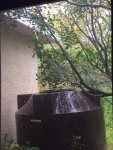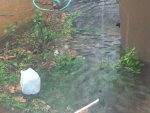This is EXACTLY what I discovered just now, when I tested, 24 hours after seeing a 2.5ppm loss in the first 24 hour period. What I saw today was an 8ppm loss over the 2nd 24 hour period! In fact, I was just getting back on here to post a question as to what might cause this, aside from testing error (more on that below), when I saw your post. The good news is that the remant patches on the plaster that have been brushed daily since starting this endeavor 3 days ago(?) are almost all gone. This fact, combined with the nearly triple FC loss I just recorded, along with your post and what someone else previously said, leads me to believe that such a big FC loss today could be partly contributed to the recent sustained higher FC level indeed being effective at killing off the algae in my pool, thus the consumption of much more FC than the first day. Granted, this assumption is based purely on what I can see, and this theory may not hold water (pun intended). That said, even if this theory is correct, this doesn't mean that I am inclined not to SLAM.
Au contraire, when I do SLAM, I will maintain that SLAM FC level as best I can, but will likely only be able to add LC twice a day.
All the more reason to ensure CYA is properly tested.
Speaking of which, I was actually wondering earlier if it was possble that my CYA test results were wrong, which might explain why I am seeing such good (in my eyes) results with the algae thus far. I doubt I erred, though, because I did the regular test first, which prompted me to subsequently do the diluted test, so I had to have been wrong twice in quick succession. To clarify, the normal test resulted in the cloudy water not even getting up to the 100 mark, and it was shy by a considerable amount. However, when I did the diluted test, it hit 50 on the nose, which indicates my level is supposedly 100. If I was wrong (first time I ever hoped I was) in my test, and my CYA is really more like 30, then I would be slamming at the levels I have been trying to keep thus far. But, that's a far reach, especially since I've been running the trichlor pucks for so darned long.
Nice thougt here, but wouldn't downspout water be too dirty to put in a pool? I have a tile roof and when I clean my gutters I see all kind of sand from the erosion of the tile in the gutters, not to mention leaves and all that. Or, is that OK, as long as that stuff isn't swimming in the water column?
While we don't have rain often, when we get it, it's BIG! I live in the foothiils right above a big lake, and the storm clouds come across the lake and park at the hills and just preciptate water out of the lake and dump them on my house. I can drive 5 miles down the hill or even just across the lake, and it will be sunny, but when I look toward my house it's black and you can't even see the hillside. So, I'm trying to live with the high CYA for the next few months. Of course, I may lose patience along the way. ;-)
I think you'll find varying amounts of chlorine lost while you're dealing with the algae. After you're done with that and maintaining at the high target for your CYA, then you'll see more consistent daily losses that align with the ~50% that pools without issues see. Normally we dose the pool at night to target, and expect to lose not quite enough to be at minimum by the next night, rinse and repeat daily. If you have extra swimmers or other conditions, then you may need to put some extra chlorine in. Right now, your chlorine loss probably is higher since you're battling the algae, although with CYA at 100 50% might very well be in the 8ppm range. It sounds like you're a solid 100, I did remember you said you did the diluted test so I didn't question it.
Insofar as the rain water, the turbidity from the roof dirt should not be much if you don't stir it up when you remove the water. Most solids will settle to the bottom, and you'll also want to put a little chlorine in the water so as to not get algae in the rain barrels. You could also invest in a small handheld pool vacuum if it really bothers you. I had one of those once and it worked pretty well.
Have you thought of going down to that lake and collecting some water? It may take some time to do enough to get 50% of your water replaced, and the water itself might have a little lake algae but it could be a way to get water for free. I once saw someone filling a waterbed bladder in the back of a pickup truck from the Willamette river with a pump. I think it was for watering plants since we were having a drought at the time.
Of course, I see the point you're making about the SLAM level and black algae. The article does say to keep your FC within the range between target and SLAM. I think folks around here are just more inclined to use the SLAM level if it's part of the options rather than a lower level because it's a lot easier on YOU if your water gets cleared up faster than slower.
Since you have to leave now... there's a chance you'll backslide unless someone can put chlorine in the water for you. I'd suggest hitting it hard while you can, which of course means lots of chlorine!
Oh, and if you do end up needing to SLAM, note that testing and adding 2x a day will make it a very slow, if not potentially ineffective process. 3x a day is the bare minimum. People who do 2x a day seem to spend considerable time posting wondering why it's not working yet... people who can do it 3+ times a day see good results.





